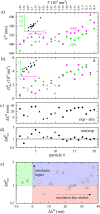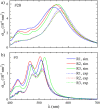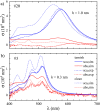Quantitatively linking morphology and optical response of individual silver nanohedra
- PMID: 35866565
- PMCID: PMC9351607
- DOI: 10.1039/d2nr02131e
Quantitatively linking morphology and optical response of individual silver nanohedra
Abstract
The optical response of metal nanoparticles is governed by plasmonic resonances, which are dictated by the particle morphology. A thorough understanding of the link between morphology and optical response requires quantitatively measuring optical and structural properties of the same particle. Here we present such a study, correlating electron tomography and optical micro-spectroscopy. The optical measurements determine the scattering and absorption cross-section spectra in absolute units, and electron tomography determines the 3D morphology. Numerical simulations of the spectra for the individual particle geometry, and the specific optical set-up used, allow for a quantitative comparison including the cross-section magnitude. Silver nanoparticles produced by photochemically driven colloidal synthesis, including decahedra, tetrahedra and bi-tetrahedra are investigated. A mismatch of measured and simulated spectra is found in some cases when assuming pure silver particles, which is explained by the presence of a few atomic layers of tarnish on the surface, not evident in electron tomography. The presented method tightens the link between particle morphology and optical response, supporting the predictive design of plasmonic nanomaterials.
Conflict of interest statement
The authors declare no conflicts of interest.
Figures






References
-
- Trügler A., Optical properties of metallic nanoparticles: basic principles and simulation, Springer, Cham, 2016
-
- Bohren C. F. and Huffman D. R., Absorption and Scattering of Light by Small Particles, Wiley-VCH Verlag, 1998
LinkOut - more resources
Full Text Sources

